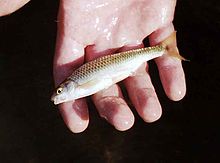
Cyprinidae is a family of freshwater fish commonly called the carp or minnow family, including the carps, the true minnows, and their relatives the barbs and barbels, among others. Cyprinidae is the largest and most diverse fish family, and the largest vertebrate animal family overall, with about 3,000 species; only 1,270 of these remain extant, divided into about 200 valid genera. Cyprinids range from about 12 mm (0.5 in) in size to the 3 m (9.8 ft) giant barb. By genus and species count, the family makes up more than two-thirds of the ostariophysian order Cypriniformes. The family name is derived from the Greek word kyprînos.

Rutilus is a genus of fish in the family Cyprinidae found in Eurasia. This genus is a widely distributed lineage of cyprinids and ranges from West Europe to East Siberia.

The common rudd is a bentho-pelagic freshwater fish, widely spread in Europe and central Asia, around the basins of the North, Baltic, Black, Caspian and Aral seas.
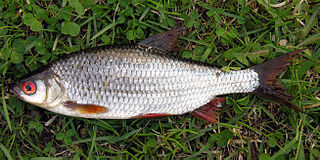
The roach, or rutilus roach, also known as the common roach, is a fresh- and brackish-water fish of the family Cyprinidae, native to most of Europe and western Asia. Fish called roach can be any species of the genera Rutilus, Leucos and Hesperoleucus, depending on locality. The plural of the term is also roach.
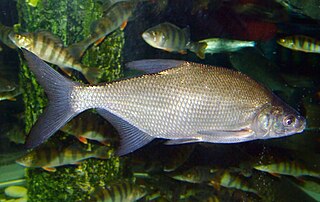
The common bream, also known as the freshwater bream, bream, bronze bream, carp bream or sweaty bream, is a European species of freshwater fish in the family Cyprinidae. It is now considered to be the only species in the genus Abramis.

Chondrostoma soetta, or the Italian nase, is a species of freshwater fish in the family Cyprinidae. It is found in Italy, Slovenia, and Switzerland. Its natural habitats are rivers and freshwater lakes. It is threatened by habitat loss and predation and competition from introduced species such as roach, wels catfish and the common nase. It has been extirpated from Slovenia and numbers are declining in the Italian and Swiss lakes of Lake Como, Lake Lugano, Lake Maggiore, Lake Iseo and Lake Garda. Some population which are descended from fish introduced to other lakes in Italy appear to be thriving.
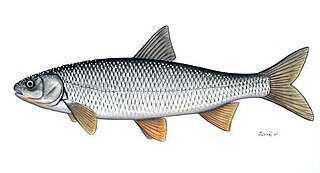
Rutilus frisii, called the vyrezub, Black Sea roach, or kutum, is a species of fish in the family Cyprinidae, native to the basins of the Black Sea, Sea of Azov, and Sea of Marmara from the rivers of Bulgaria to western Transcaucasia and in Lake Iznik (Turkey).

Rutilus meidingeri is a species of freshwater fish in the family Cyprinidae. It is only found in three subalpine lakes in Austria and probably in few lakes of Slovakia. Since the 1980s, it has been extirpated from the German Lake Chiemsee and Austrian Traunsee.
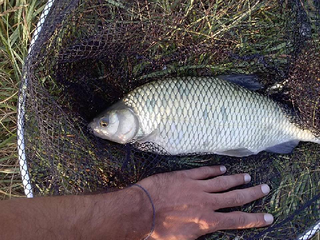
The pigo is a species of freshwater fish in the roach genus Rutilus of the family Cyprinidae. The fish is native to northern Italy and Switzerland. It inhabits subalpine lakes of the northern Adriatic basin from the Livenza to the Po drainage, including Lakes Maggiore, Lugano, and Como.

Leuciscinae is a subfamily of the freshwater fish family Cyprinidae, which contains the true minnows.

The cactus roach is a species of fish in the family Cyprinidae, native to the basin of the Danube River upstream of the Iron Gate, very numerous in the Sava basin. It is also recorded in the Ukrainian Zakarpattian region. This freshwater fish is up to 55 cm long.
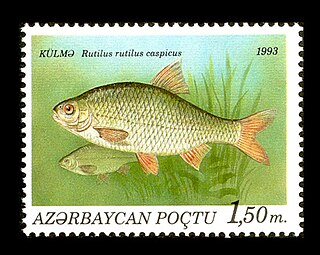
The Caspian roach is a species of roach fish living in the Caspian Sea. The Caspian roach can be distinguished from other roaches by its laterally compressed body, silvery grey iris, rounded snout and grey pectoral pelvic and anal fins with dark margins. The Caspian roach is semi-anadromous and inhabits mostly shallow coastal waters. It enters Volga, Ural, Emba, Terek and Kura drainages for spawning.

Leucos is a genus of fishes in the family Cyprinidae, from Southern Europe. They are carp close to the genus Rutilus, and were only recently taxonomically distinguished from that genus.

Leucos aula is a species of freshwater fish in the family Cyprinidae. It is native to the Adriatic basin in southern Europe, originally occurring in Italy, Slovenia, Croatia, and Switzerland. It has been introduced to other parts of Italy. This is an abundant fish, occurring in canals, swamps, lakes, and streams with slow current and dense vegetation.
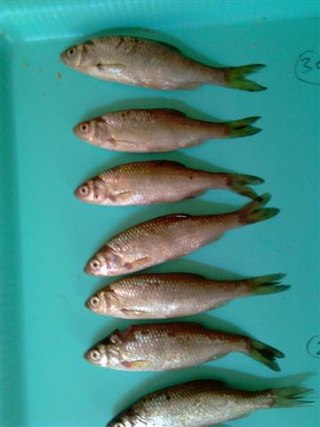
Leucos basak, the Albanian roach, Dalmatian roach or Croatian roach, is a species of freshwater fish in the family Cyprinidae. It is found in Albania, Bosnia and Herzegovina, Croatia, and Serbia and Montenegro.
Leucos ylikiensis is a species of freshwater fish in the family Cyprinidae. It is found only in Greece, in the Kifissos drainage and Lake Yliki. The other known population, in Lake Paralimni, was extirpated when the lake was drained. L. ylikiensis was described as a distinct species in 1991. It is threatened by habitat loss.
Squalius malacitanus, commonly known as the Málaga chub, is a species of freshwater fish in the carp family Cyprinidae. It was first isolated from the Guadalmina River in Málaga, hence its name. It is considered a vulnerable species. S. malacitanus differs from its cogenerate species by having 7–8 branched rays in its dorsal fin, 8 branched rays in the anal lateral line; the number of scale rows above its lateral line; possessing 3 scale rows below its lateral line; 38 vertebrae, 21 abdominal, and 17 caudal; large fourth and fifth infraorbital bones; maxilla without a pointed anterior process; the middle of its frontal bone being narrow, as well as its neurocranium bone; the lower branch of its pharyngeal bone is rather long; and the shortness of the inferior lamina of its urohyal bone.
Leucos panosi, also known as the Achelous roach, is a species of freshwater fish in the family Cyprinidae. Acheloos and Louros river systems in Greece, and lakes Trichonis and Ambrakia.

Nuptial tubercles are dermal structures present in 15 families of fish belonging to 4 orders of Actinopterygii – Salmoniformes, Gonorhynchiformes, Cypriniformes and Perciformes – used in the courtship and reproduction process. They consist of partially or fully keratinised cells that form a perceptible protrusion in certain regions, used to stimulate females during courtship. Their development is stimulated by hormones secreted by the pituitary and adrenal glands, and is induced shortly before the breeding season and discarded after. In some species, at least, there is a correlation between the level of androgens present in the endocrine system and the volume and complexity of tubercle growth.
Rutilus stoumboudae is a species of freshwater fish in the family Cyprinidae. It is found only in Greece, in Lake Volvi and is a lacustrine species adapted to still water. It is named for Maria Stoumboudi, in honour of her research on the ecology and conservation of the freshwater fishes of Greece.
